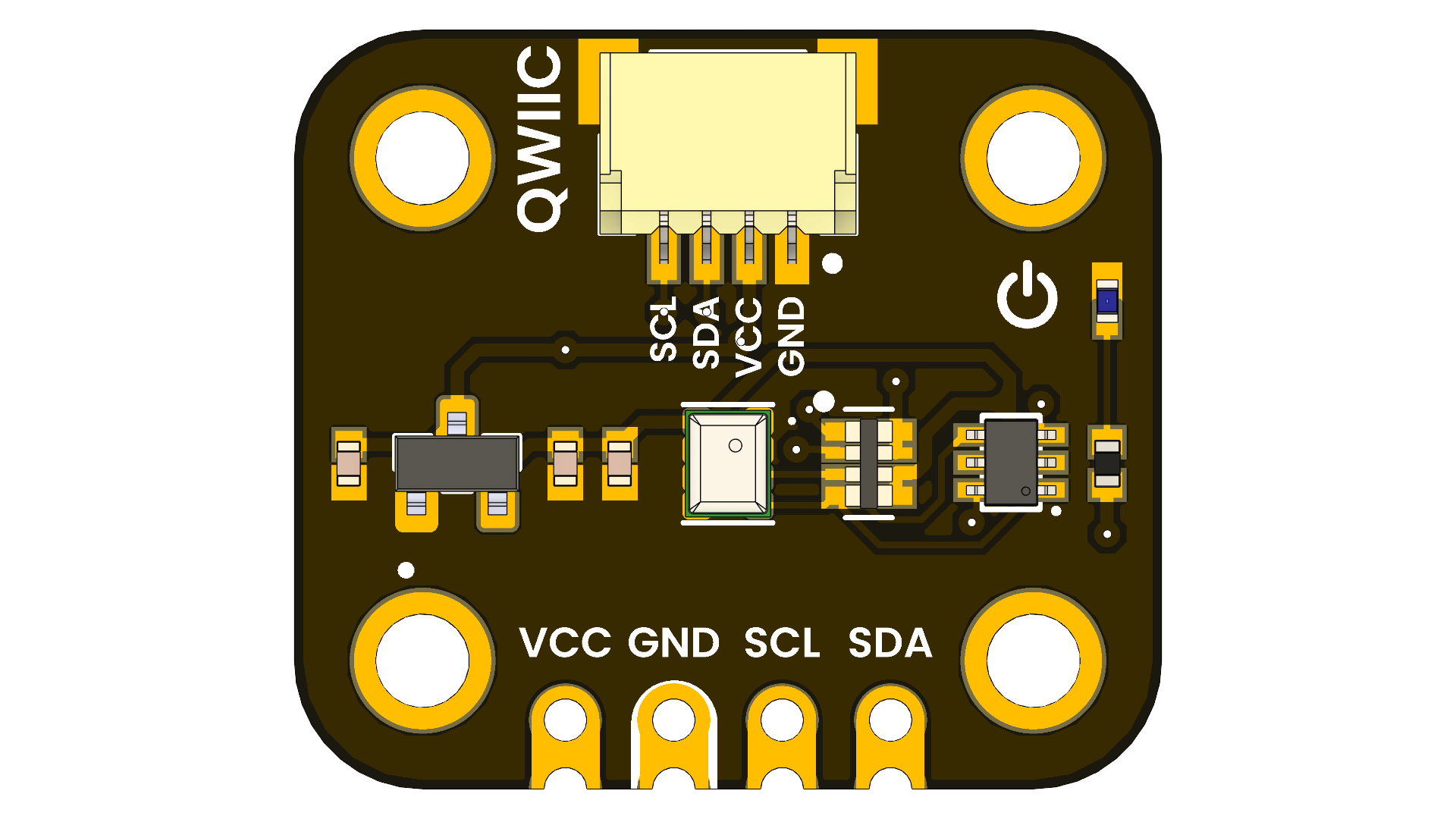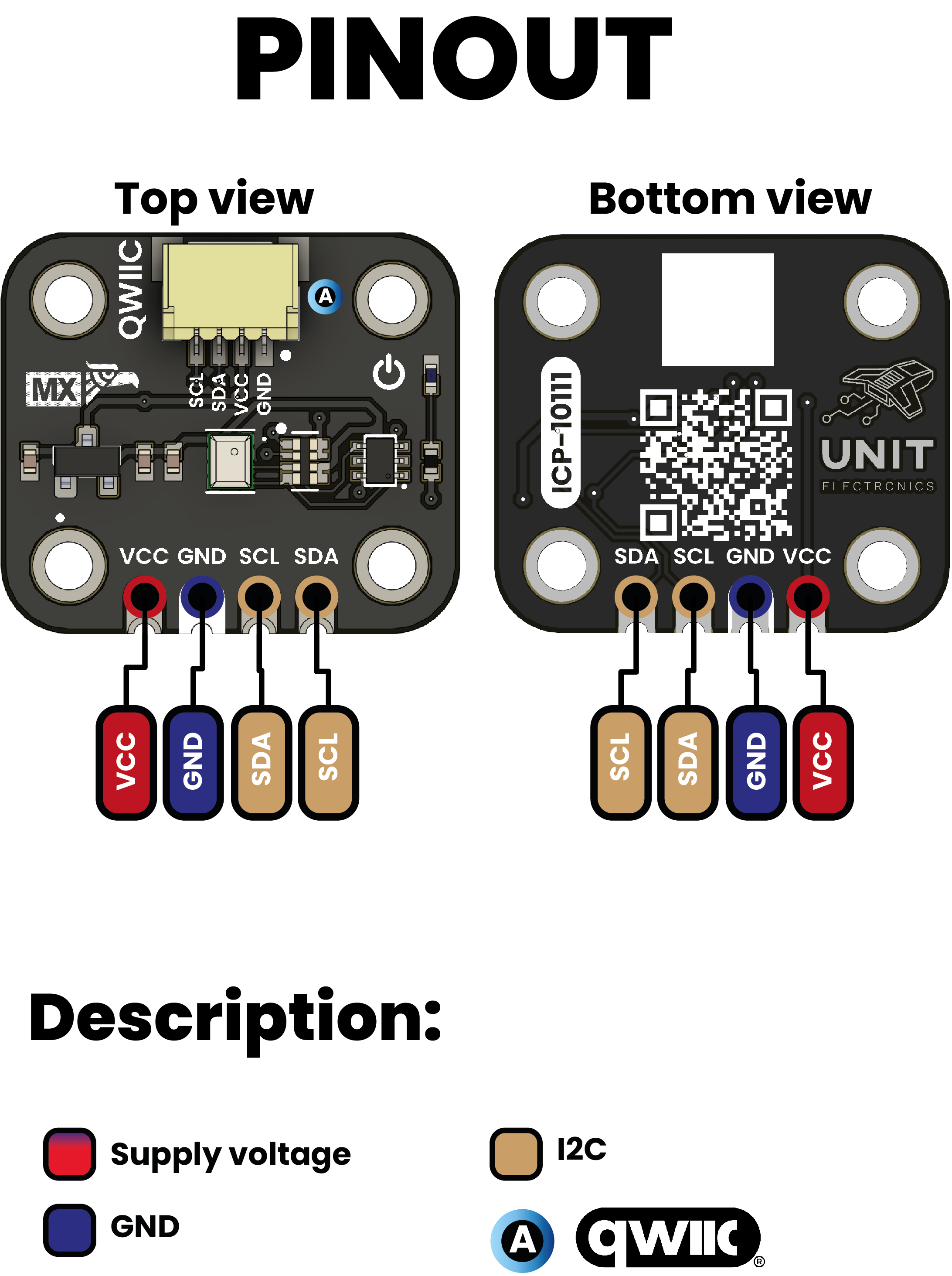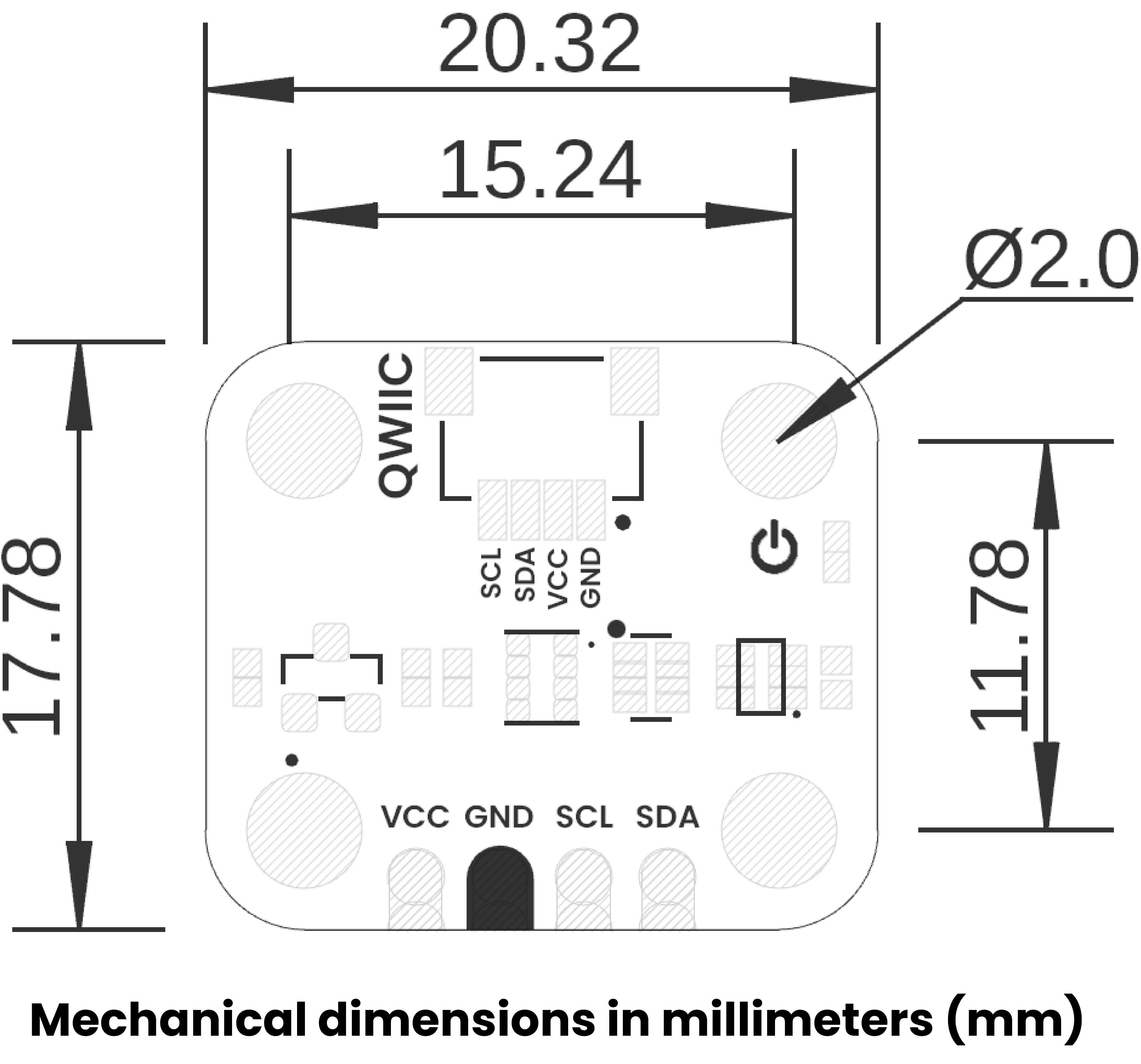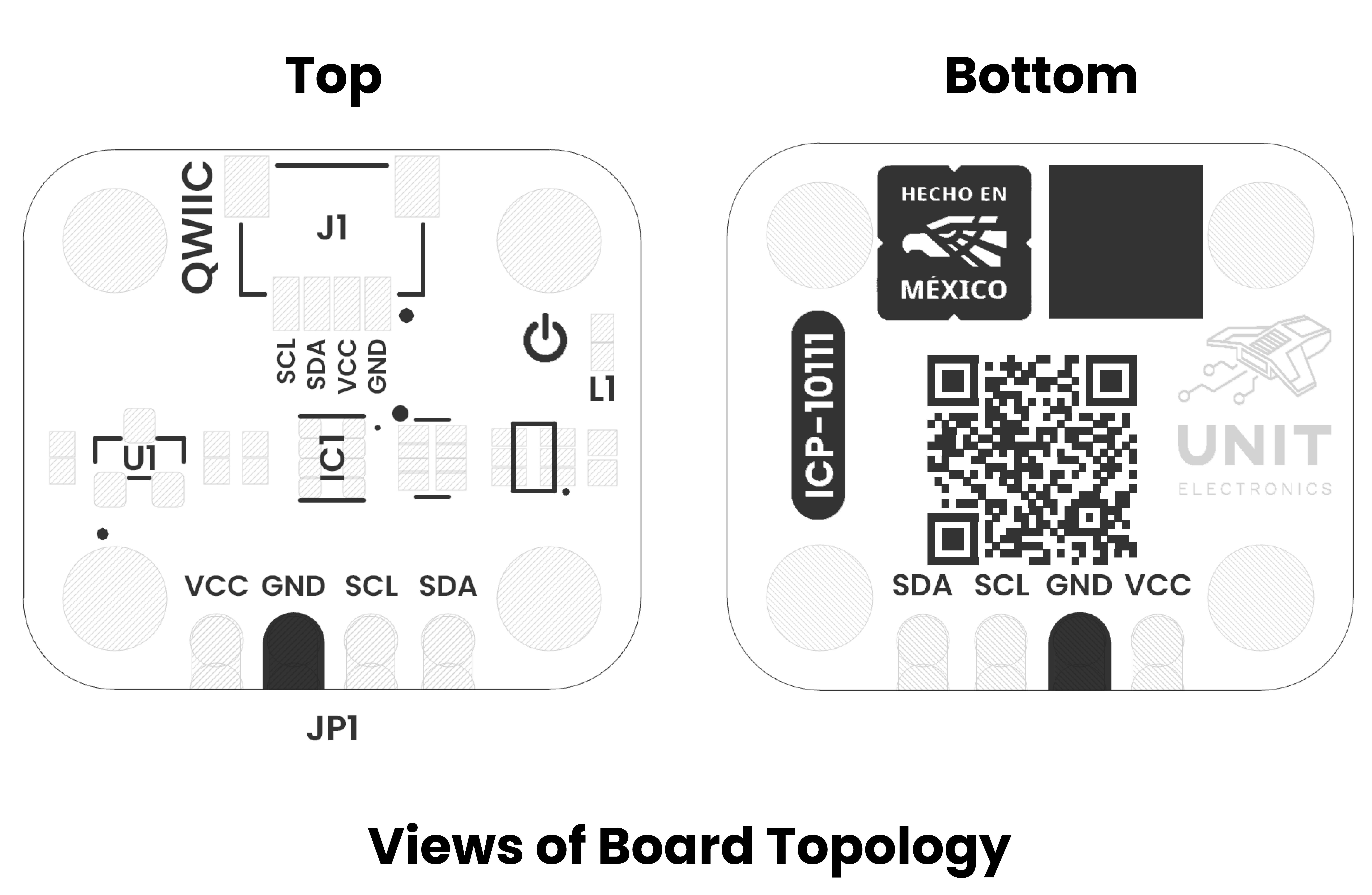ICP-10111 Barometric Pressure Sensor Module
Introduction
The UNIT ICP-10111 Barometric Pressure Sensor Module is a compact and efficient sensor designed for high-accuracy atmospheric pressure measurements with low power consumption. Based on MEMS capacitive technology, this module offers ultra-low noise performance, exceptional relative accuracy, and stable sensor throughput. Ideal for weather monitoring, altitude measurement, and environmental sensing, it delivers industry-leading precision in demanding applications.

📦 Overview
| Feature | Specification |
|---|---|
| Pressure operating range | 30 to 110 kPa |
| Noise and current consumption | ULN mode: 0.4 Pa @ 10.4 µA LN mode: 0.8 Pa @ 5.2 µA LP mode: 3.2 Pa @ 1.3 µA |
| Pressure Sensor Relative Accuracy | ±1 Pa for any 10 hPa change over 950 hPa–1050 hPa at 25°C |
| Pressure Sensor Absolute Accuracy | ±1 hPa over 950 hPa–1050 hPa, 0°C to 65°C |
| Pressure Sensor Temperature Coefficient Offset | ±0.5 Pa/°C over 25°C to 45°C at 100 kPa |
| Temperature Sensor Absolute Accuracy | ±0.4°C |
| Temperature operating range | -40 °C to 85 °C |
| Host Interface | I2C at up to 400 kHz |
| Single Supply voltage | 1.8V ±5% |
| RoHS and Green compliant | Yes |
🚀 Getting Started
- Connect the board via USB-C to your computer.
- Install the appropriate board package for:
- Arduino IDE
- PlatformIO
- ESP-IDF / Pico SDK
- Flash a sample project or use one from
/software/examples - Power via USB or external battery (if supported)
🧪 Use Cases
- Weather stations
- Altitude measurement for drones and UAVs
- Environmental monitoring systems
- Indoor navigation and smart building systems
📚 Resources
📝 License
All hardware and documentation in this project are licensed under the MIT License.
Please refer to LICENSE.md for full terms.
Hardware Overview
🔌 Pinout
📏 Dimensions
📃 Topology
| Ref. | Description |
|---|---|
| IC1 | ICP-10111 Barometric Pressure Sensor |
| L1 | Power On LED |
| U1 | ME6206A18XG 1.8V Regulator |
| JP1 | 2.54 mm Castellated Holes |
| J1 | QWIIC Connector (JST 1 mm pitch) for I2C |
Pin & Connector Layout
| Pin | Voltage Level | Function |
|---|---|---|
| VCC | 3.3 V – 5.5 V | Provides power to the on-board regulator and sensor core. |
| GND | 0 V | Common reference for power and signals. |
| SDA | 1.8 V to VCC | Serial data line for I²C communications. |
| SCL | 1.8 V to VCC | Serial clock line for I²C communications. |
Note: The module also includes a Qwiic/STEMMA QT connector carrying the same four signals (VCC, GND, SDA, SCL) for effortless daisy-chaining.
Functional Description
The ICP-10111 is a high-precision barometric pressure sensor module based on capacitive MEMS technology.
- Measures absolute pressure over 30 kPa–110 kPa and integrates a temperature sensor for real-time thermal compensation.
- Delivers ±1 Pa differential accuracy (≈5 cm altitude resolution) and ±1 hPa absolute accuracy across –40 °C…+85 °C.
- Built-in 24-bit ΔΣ ADC and I²C interface allow direct digital readout without external amplification.
- Three programmable power/noise modes (Ultra-Low Noise, Low Noise, Low Power) optimize trade-off between current draw and resolution.
- Breakout board includes onboard 1.8 V regulator, level-shifting I/O and four mounting holes for easy integration.
Applications
- Weather Stations & Barographs
- Altimeters & UAVs
- Indoor/Outdoor Navigation
- Wearables & IoT
- Climatology & Research
- Weather Forecasting
References
Pinout
Dimensions
Topology
| Ref. | Description |
|---|---|
| IC1 | ICP-10111 Barometric Pressure Sensor |
| L1 | Power On LED |
| U1 | ME6206A18XG 1.8V Regulator |
| JP1 | 2.54 mm Castellated Holes |
| J1 | QWIIC Connector (JST 1 mm pitch) for I2C |
Pin & Connector Layout
| Pin | Voltage Level | Function |
|---|---|---|
| VCC | 3.3 V – 5.5 V | Provides power to the on-board regulator and sensor core. |
| GND | 0 V | Common reference for power and signals. |
| SDA | 1.8 V to VCC | Serial data line for I²C communications. |
| SCL | 1.8 V to VCC | Serial clock line for I²C communications. |
Note: The module also includes a Qwiic/STEMMA QT connector carrying the same four signals (VCC, GND, SDA, SCL) for effortless daisy-chaining.
Functional Description
The ICP-10111 is a high-precision barometric pressure sensor module based on capacitive MEMS technology.
- Measures absolute pressure over 30 kPa–110 kPa and integrates a temperature sensor for real-time thermal compensation.
- Delivers ±1 Pa differential accuracy (≈5 cm altitude resolution) and ±1 hPa absolute accuracy across –40 °C…+85 °C.
- Built-in 24-bit ΔΣ ADC and I²C interface allow direct digital readout without external amplification.
- Three programmable power/noise modes (Ultra-Low Noise, Low Noise, Low Power) optimize trade-off between current draw and resolution.
- Breakout board includes onboard 1.8 V regulator, level-shifting I/O and four mounting holes for easy integration.
Applications
- Weather Stations & Barographs
- Altimeters & UAVs
- Indoor/Outdoor Navigation
- Wearables & IoT
- Climatology & Research
- Weather Forecasting
References
Getting Started
Quick Setup
1. Hardware Connections
- VCC → 3.3V or 5V supply
- GND → Ground
- OUT → Digital input pin on your microcontroller
Compatible with a JST 1 mm pitch QWIIC connector for easy I2C integration (power only, D0 must be connected separately).
Examples
Arduino/C++ Examples
The following examples demonstrate various features of this development board.
⚡ example_1: example_1.ino
/******************************************************************
Base code for TDK InvenSense ICP-10111 barometric pressure sensor.
Outputs:
- Temperature in °C
- Pressure in Pa
- Relative altitude in meters
Altitude is calculated using the barometric formula assuming standard atmosphere.
Written by OpenAI based on original example from Adrian Studer.
******************************************************************/
#include <icp101xx.h>
#include <math.h> // For pow()
ICP101xx sensor;
// Reference pressure at startup (in Pa)
float reference_pressure = 0.0;
void setup() {
Serial.begin(115200);
Datasheet & Documentation
📄 Professional Datasheet
Complete technical specifications and professional documentation.
📎 View Professional Datasheet - Interactive HTML version
📎 Download PDF Datasheet - Downloadable PDF version
🔗 Additional Resources
Hardware Resources
- 🔌 Schematic Diagram - Complete circuit schematic
- 📐 Board Dimensions - Physical specifications
- 🔧 Pinout Reference - Pin configuration details
Software Resources
- 💻 Getting Started Guide - Setup and first steps
- 📝 Code Examples - Arduino sketches and demos
- 🛠️ Development Setup - IDE configuration
External Links
- 🔗 Source Code Repository - Complete project files
📋 Quick Reference
| Resource Type | Description | Link |
|---|---|---|
| 📄 Datasheet (HTML) | Interactive technical specs | View |
| 📄 Datasheet (PDF) | Downloadable technical specs | |
| 🔌 Schematic | Circuit diagram | |
| 📐 Dimensions | Board measurements | View |
| 🔧 Pinout | Pin configuration | View |
| 💻 Examples | Code samples | View |
| 🔧 Setup Guide | Getting started | View |
For the most up-to-date information, please refer to the official documentation and repository.
License
MIT License
Copyright (c) 2025 UNIT-Electronics-MX
Permission is hereby granted, free of charge, to any person obtaining a copy of this software and associated documentation files (the "Software"), to deal in the Software without restriction, including without limitation the rights to use, copy, modify, merge, publish, distribute, sublicense, and/or sell copies of the Software, and to permit persons to whom the Software is furnished to do so, subject to the following conditions:
The above copyright notice and this permission notice shall be included in all copies or substantial portions of the Software.
THE SOFTWARE IS PROVIDED "AS IS", WITHOUT WARRANTY OF ANY KIND, EXPRESS OR IMPLIED, INCLUDING BUT NOT LIMITED TO THE WARRANTIES OF MERCHANTABILITY, FITNESS FOR A PARTICULAR PURPOSE AND NONINFRINGEMENT. IN NO EVENT SHALL THE AUTHORS OR COPYRIGHT HOLDERS BE LIABLE FOR ANY CLAIM, DAMAGES OR OTHER LIABILITY, WHETHER IN AN ACTION OF CONTRACT, TORT OR OTHERWISE, ARISING FROM, OUT OF OR IN CONNECTION WITH THE SOFTWARE OR THE USE OR OTHER DEALINGS IN THE SOFTWARE.
This project is licensed under the MIT License - see the LICENSE file for details.






